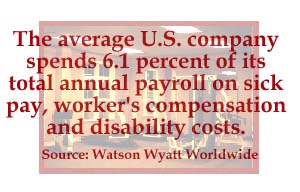|
Wellness programs evolve
|
 |
May 11, 1999: 3:54 p.m. ET
Companies are becoming more proactive in monitoring their employees' health
|
NEW YORK (CNNfn) - Employee wellness programs are nothing new to Boeing Corp.
The Seattle-based aerospace giant began bringing physicians to its plants in the 1920s, part of its effort to better monitor the health of workers and educate them on individual risk factors.
In the 1960s, the company set up on-site health and fitness programs. It also began regular fitness testing of executives and added counseling services to its menu of offerings.
Now, Boeing is taking the concept of risk assessment one step further.
"We are looking at all the various tools and we're partnering with our vendors to come up with a more streamlined process," said Holly Stapnes, the company's health management administrator.
Boeing, she said, will begin a new (voluntary) pilot program later this year that will enable employees and their families to identify their individual risk factors and choose from a range of programs designed to reduce those risks. Weight loss and cholesterol management courses are just two of the classes that will be made available.
"Wellness has gotten even broader and the most critical pieces are education and awareness," Stapnes said. "The idea here is to lead employees into health improvement programs, either through classes or by using the phone or Internet - whatever is easiest for them. We are really going out to the people instead of making them come to us."
Boeing (BA) is not alone.
The company, with some 220,000 employees worldwide, is one of hundreds of large- and mid-sized corporations adding outreach components to their workplace wellness initiatives.
Others include: Johnson & Johnson (JNJ), Union Pacific (UNP), Caterpillar (CAT), Dow Chemical (DOW), Woodward Governor (WGOV) and Health Partners, a health maintenance organization in Minneapolis.
"One of the biggest trends [in this industry] is the movement to proactivity," said Larry S. Chapman, chairman of health management service provider Summex Corp. and author of several books on workplace wellness. "We are seeing companies go from reactive programs, where you put the materials out on the table at some health fair and hope whoever needs it can find it, to active recruitment."
Fitness
The most common workplace wellness programs include one or more of the following: on-site fitness centers; subsidies to help offset the costs of local gyms; toll-free counseling to help cope with stress; and annual health fairs, where free blood pressure and cholesterol screens are administered.
Some, too, offer weight management and "stop smoking" classes.
Barbara Taylor, head of Rainbows & Miracles Etc., a management consulting firm in Silverado, Calif., said incentive programs that reward employees for staying fit are also fairly common.
Workers might get to reduce their paycheck contributions to the company health plan, for example, if they participate in a weight loss program or take active steps to quit smoking.
"One company I work with offers executives physicals every year and if they keep their cholesterol low, or indicate that they don't smoke, they get a certain amount of dollar points that offset what they pay for health insurance," Taylor said. "It's a reimbursement for staying healthy."
Still other companies hire third party vendors, like Summex Corp., to administer health risk appraisals. For the most part, the questionnaires are voluntary and ask employees to answer a series of health-related questions. All information is kept confidential.
The tests are scored against an average and returned to the employee for their perusal. The idea is to make the workers more aware of their individual risks.
That's where the proactive approach comes in.
"If someone fills out our health risk appraisal and indicates that their satisfaction with life is extremely low, or their alcohol use is very high, that is someone a health educator on our staff would call," Chapman said. "They would tell the person a few things caught their eye and ask if they would like some help."
Other ways companies are reaching out, he said, include mandatory health and fitness program orientation classes for new workers. The employees do not have to use the facilities, of course, but they are automatically educated on the programs available.
Some companies also send out regular e-mails to employees via a corporate Intranet, keeping them informed of the various fitness- and mental health-related programs offered.
"Basically, being proactive really deals with trying to reach people directly, or doing the things that we used to call outreach," Chapman said.

The cost of "sick" offices
Wellness programs are designed with several goals in mind. Most companies use them to improve employee morale, reduce health care costs and ebb the tide of absenteeism.
To that end, numerous studies show a direct correlation between positive corporate culture and wellness programs.
A 1998 workplace survey conducted by Watson Wyatt Worldwide, 92 percent of employers cited job dissatisfaction as the second most significant factor leading to time lost from work.

One of the most common causes for absenteeism, the report found, was muscular skeletal pains, including backaches and other symptoms that can result from lack of exercise.
The study also shed some light on the indirect cost of an unhealthy workforce.
On average, it said, U.S. companies allocate 6.1 percent of their total annual payroll on sick pay, worker's compensation claims and short- and long-term disability expenses. About 3 percent of payroll is allocated to overtime costs, and 2.7 percent is used to pay for temporary employees who fill in sick or absent workers.
But linking wellness programs to productivity is far more difficult.
Andrew Sandor, a spokesman for Watson Wyatt Worldwide, said there are just too many variables that come into play.
"A lot of firms use these programs to promote employee morale and to attract and retain employees, and those are excellent goals," he said. "But is there a real connection to productivity? Maybe. Maybe not. The jury is still out on that one."
He said wellness programs are especially effective if the sponsoring company has realistic goals in mind.
Chapman, however, said productivity can be a goal for wellness programs. But he acknowledged that data on the subject is still far from complete.
"The literature is pretty clear that these programs have a great ability to make a major contribution to productivity," he said. "We just have not documented these effects, nor have we designed programs to specifically target productivity."
As for the overall benefit of wellness programs, Chapman said the 32 studies he has reviewed on the subject speak for themselves.
Six studies found that 49 percent of companies offering health intervention components as part of their programs reported lower-than-expected health care costs.
One study found that 63 percent of companies reported a drop in hospital admissions after implementing their programs.
And 10 studies determined the cost-benefit ratio was around 1-to-3. (In other words, the companies reported gaining $3 worth of benefits for every dollar spent.)
"These programs do in fact have the ability to have a significant impact and can be engineered to have an even more expansive impact," he said. "If you define productivity as a measure of efficiency, and you reduce health costs, sick leave, absenteeism, etc., you've increased productivity." 
--by staff writer Shelly K. Schwartz
|
|
|
|
|
 |

|

